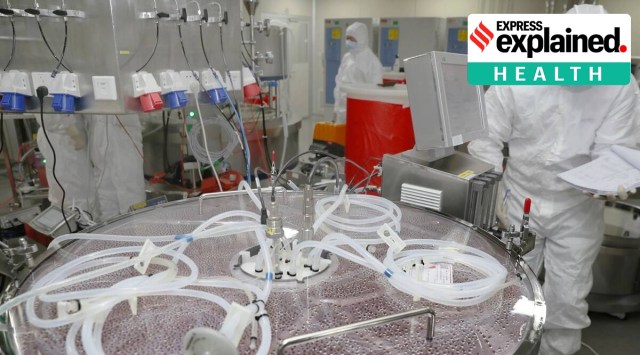In China, a first inhalable vaccine against Covid-19: Can needle-free work?
The inhalable vaccine has been developed by the Chinese biopharmaceutical company CanSino Biologics Inc. as an aerosol version of its one-shot adenovirus vaccine, which uses a relatively harmless cold virus.
 An employee works on the production of the recombinant novel coronavirus vaccine (adenovirus Type 5 vector or Convidecia) for the Chinese vaccine developer CanSino Biologics Inc. (CanSinoBio) at Thousand Oaks Biopharmaceutical in Haimen in eastern China's Jiangsu province on Monday, Sept. 6, 2021. (Chinatopix Via AP/File)
An employee works on the production of the recombinant novel coronavirus vaccine (adenovirus Type 5 vector or Convidecia) for the Chinese vaccine developer CanSino Biologics Inc. (CanSinoBio) at Thousand Oaks Biopharmaceutical in Haimen in eastern China's Jiangsu province on Monday, Sept. 6, 2021. (Chinatopix Via AP/File)Authorities in Shanghai have started administering an inhalable vaccine against Covid-19, apparently a world first, the Associated Press reported on Wednesday. The vaccine is being offered for free as a booster dose for previously vaccinated people, according to an announcement on an official city social media account, the report said.
Like a ‘sweet’ mist
The vaccine is a mist that is sucked in through the mouth, the AP reported. A video posted by an online Chinese state media outlet showed people at a community health centre sticking the short nozzle of a translucent white cup into their mouths, the report said.
The accompanying text said that after slowly inhaling, people hold their breath for five seconds, with the entire procedure completed in 20 seconds. “It was like drinking a cup of milk tea,” one Shanghai resident said in the video, according to the AP report. “When I breathed it in, it tasted a bit sweet.”
The inhalable vaccine has been developed by the Chinese biopharmaceutical company CanSino Biologics Inc. as an aerosol version of its one-shot adenovirus vaccine, which uses a relatively harmless cold virus, the AP said.
Intranasal vaccine
In September this year, India’s national drug regulator cleared Hyderabad-based Bharat Biotech’s iNCOVACC, the country’s first intranasal Covid-19 vaccine for emergency use in unimmunised adults.
iNCOVACC, which uses a modified chimpanzee adenovirus, will be delivered through the nasal route, which would potentially trigger an immune response in the mucosal membrane. It has been designed to not only protect against infection but also reduce transmission of the virus.
The vaccine is not yet part of India’s national immunisation programme. Bharat Biotech, the manufacturer of Covaxin, had first announced an intranasal vaccine in September 2020, after the first wave of the pandemic. It was widely billed as a potential gamechanger at the time.
Easy to deliver
Any needle-free vaccine — the intranasal formulation or the inhalable type developed by CanSino — would be easy to administer, and would cut down on the dependence on trained personnel, ultimately making mass immunisation more accessible in poorer countries and countries with inadequate healthcare infrastructure. Also, experts have pointed out that needle-free shots might persuade those who do not like to be injected to get the vaccine.
(Zydus Cadila’s ZyCoV-D, the first Covid-19 vaccine built on a DNA platform, is an intradermal vaccine that is applied through the skin, but using a needle-free system.)
Questions remain
While around a dozen nasal vaccines are being tested globally according to the World Health Organization, the effectiveness of non-needle vaccines is yet to be fully tested. Save for some flu vaccines, this route of delivery has not been very successful so far.
Also, only very small volumes of the vaccine can be squirted into each nostril, and the same would be true for inhalable formulations as well.
- 01
- 02
- 03
- 04
- 05






































